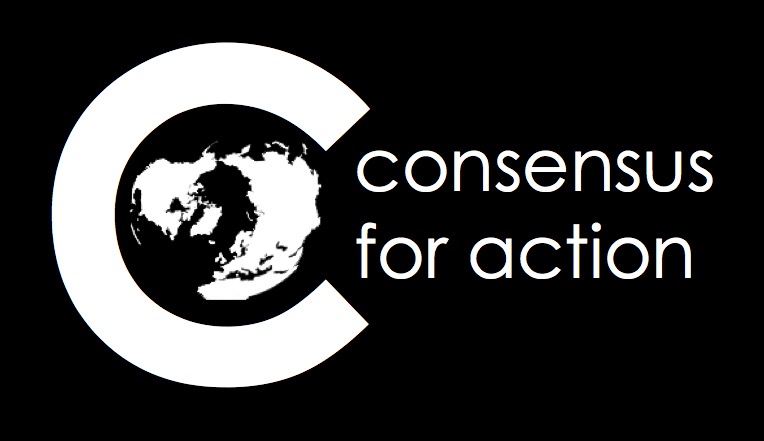By Anthony D. Barnosky, Professor in the Department of Integative Biology, Curator in the Museum of Paleontology, and Research Paleoecologist in the Museum of Vertebrate Zoology at the University of California, Berkeley. His new book Dodging Extinction: Power, Food, Money, and the Future of Life on Earth (University of California Press, Fall 2014) explores in more detail how people can keep wild species and wild places on Earth.
The Mighty Zambezi
It's not Victoria Falls, or the Zambezi River around here. It's the MIGHTY Victoria Falls, and the MIGHTY Zambezi River. The why of that is pretty obvious when you see the falls, but that comes later. First we hopped on a small boat and went upriver a ways. The safety instructions were pretty casual, and life jackets weren't a part of the program. Much more critical was the location of the anchor. Which makes sense, I guess, when you consider we were only a mile or so above the falls.
You wouldn't want to go over them, of course, so in case of trouble, say, a stalled motor, you'd want to drop that anchor fast. If you didn't, your fate would be the same as befalls the occasional elephant or hippo who gets caught in a stronger current than they were counting on as they try to swim to or from one of the many islands that pepper the mighty Zambezi: a fast ride to a very watery grave. The other essential part of the safety lecture involved knowing where the liquor was: Mosi beer, gin, whiskey. Drink your fill, we were told, and then our boatman pointed the bow upstream and we were on the way.
This was a different take on the wild. Elegant hotels on the Zambia side, and I presume the same across the river in Zimbabwe, but in the river and on its islands, crocodiles, monitor lizards, hippos, elephants. Somehow, those river-bound animals seemed wilder than most of what we'd seen in the South African game reserve. They were more shy, for one thing. Some of them seemed a little crabbier—we hightailed it out of one area when a hippo took offense at us, first lifting his backside out of the water and cranking his tail like a propeller to spread his feces in order to mark his territory. Then he disappeared under water, and surfaced at our stern heading our way. Or maybe he was just cranky with the elephants chomping down the tall grass on the marshy island, grass he was probably hoping to eat that evening.
The crocodiles seemed for the most part unfazed by us, or anything else, although a couple of them did slip into the water as we approached. That made it pretty clear why lifejackets weren't really a big part of the safety program. Maybe too that's why we were encouraged to drink our fill. If you go overboard in these waters, there would be certain advantages to being appropriately anesthetized.
I got the feeling that the river ruled these islands, not people. It's a force of nature clearly beyond our control—at least in stretches like that part of the Zambezi we were on, that still respond to the ebb and flow the moisture falling hundreds of miles upstream in their drainage basins, and that have not yet been tamed by a dam. So I'm thinking that to really be "wild," a place has to have a big element of untamed, by which I mean, cannot be controlled by people.
Or at least, people's control has to be a lot less than what is out of their control.
That is definitely the case for the mighty Victoria Falls themselves. A walk along the rim makes that readily apparent. The first thing you see is the mist; actually, you see that from miles away, but when you get close, it's mist and double rainbows. Further into the cloud of spray, the water crashing over the lip of the basalt precipice becomes visible and as you sweep your gaze to the left, you see more, and more, and more foamy white wall, but you never see the other side. It goes on out of your line of sight. Farther along the trail, you run into the most intense rainstorm you'll ever walk through, but it's not rain. It's the mist from the falls, and you keep getting drenched for several hundred yards. What goes up must come down, and what's coming down are sheets of water drops falling from the blue sky. I'm soaked to the skin in seconds, but it feels good. This is all engulfing. The only sound is the roar of the falls.
Click the picture to hear the roar of the falls (QuickTime Required)
That's wild, but it's not alive. So for me, it's not totally wild, because wild means wild living things as part of the landscape too. There are no big cats on the Zambia side—we're assured they've all been "taken care of." We're safe.
Actually though, there are big cats, but well confined as money makers for an outfit that provides the opportunity for interlopers like me to "walk with the lions." I couldn't bring myself to do that. It just seemed wrong, to go against my grain. Not least of which because the lions are "orphans." I mean, just how many ways can a lion cub become an orphan, without the intervening hand of man?
That's just me though. Several in our group bought tickets and not only walked with the lions, but also petted them (only on the back though; apparently you are supposed to stay away from their ticklish ears and heads). They loved it, and I suspect I would have too. Before they went, I asked a couple of them to find out what happens to the lions after they get too big to "walk with," when they begin to get close to full grown. The report is that the orphans at that point are taught to find their own food increasingly without human help, and when they are ready, they are placed back into the "wild," in places where lion populations are in trouble. Which of course theoretically would give a wide choice of areas to place them.
That is a rosy picture, and I hope it's true. If so, I'm ok with it, I guess. The lions help local people make a living, and the local people help lions stay on Earth. I think I'd want to run down exactly where those orphan lions come from though, and where they end up. While here we've also been told of lion "farms" that raise the animals to adulthood in order to drop them into big-game hunting preserves, a misnomer in my mind, in that the animals are bought and paid for in advance, and the hunter is led to the right place to execute it. That too helps keep lions on Earth, in an odd way. I've hunted myself, and I’ve got nothing against hunting when it's a fair fight. But I don't see much difference between the canned hunting that takes place in some of those hunting preserves and leading a lamb to the slaughter.

The Zambezi River is in the background.
Photo courtesy of Elizabeth Hadly.
It's a complicated question, this business of keeping wild animals from going extinct. Our colonial-era hotel sits right on the bank of the Zambezi, so the hippos and elephants occasionally wander up onto the nicely manicured lawn. I guess they are to some extent habituated to people, but they're still the boss. That's a step up from the zebras and giraffes that roam the property, which eat out of troughs the grounds keepers fill.
So there you have it. This area around the mighty Victoria Falls is wild in the river, and tame on the bank. It's one way for people to share common ground with some other big animals that are vulnerable to extinction. Game reserves like the one we came from in South Africa are another. But the problem for me is, those solutions make my version of the wild a thing of the past.
I want a version of wild that feels wild.
(Next week: the Okavango Delta in Botswana.)

